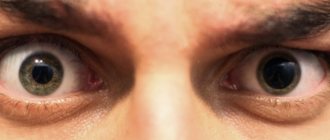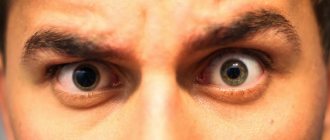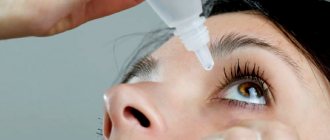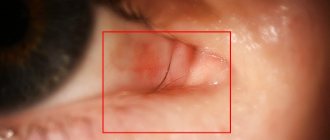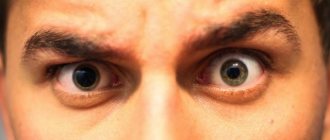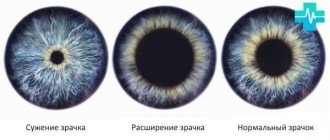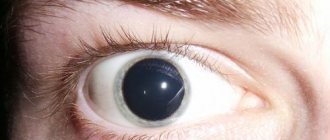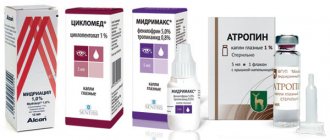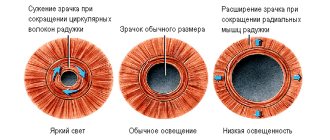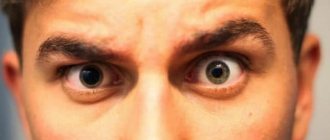Indications
Substances for the expansion of the pupils are also prescribed by ophthalmologists to eliminate spasms of accommodation. This pathology occurs during long-term intensive work (for example, with a PC or while reading), which leads to increased negative effects on vision. Consulting with a specialist will help you avoid getting confused about the types of medications.
There are two types of such medications:
- straight – promote muscle contraction;
- indirect – impact on the orbicularis muscle, reducing the intensity of contractions.
They are widely used for inflammatory diseases of the iris and ciliary body, which helps bring it to a state of calm and reduce the number of complications.
The mechanism and duration of action of drops for dilating pupils
In order to dilate the pupil, there are currently 4 drugs, three of which are m-anticholinergics (atropine, cyclomed, tropicamide), and one drug is an alpha-adrenergic agonist (phenylephrine).
M-anticholinergics block the cholinergic receptors of the iris and ciliary muscle, causing paralysis of accommodation and relaxation of the circular muscle of the iris. An alpha adrenergic agonist (phenylephrine) relaxes the pupillary dilator (the muscle that is supposed to constrict the pupil), thereby causing it to dilate.
Let's consider the duration of action of the most popular drops for dilating pupils:
- Atropine
: duration of mydriasis/cycloplegia* - 7-10 days/10-14 days - Phenylephrine
: duration of mydriasis/cycloplegia* - 4-6 hours/does not occur - Cyclopentolate
: duration of mydriasis/cycloplegia* - 6 hours/up to 24 hours - Tropicamide
: duration of mydriasis/cycloplegia* - 30-40 minutes/up to 2 hours - Phenylephrine
: duration of mydriasis/cycloplegia* - 4-6 hours/up to 2 hours.
* Cycloplegia is paralysis of the ciliary muscle of the eye.
Features of the procedure
The medicine is administered with a pipette dispenser for therapeutic and prophylactic purposes. Subsequently, the drug enters, which acts on the muscles that control the pupil, its expansion occurs due to the interaction of receptors.
The receptors lose their ability to control the visual system for some time and relax. The validity period depends on what components are included in the composition. On average, the effect on receptors lasts from 2 hours to 2 days. For people with light eyes, this lasts longer than for people with brown eyes.
When checking the eyes of children of primary school age, doctors always use relaxing drops, because in a child it is most difficult to check the state of the visual system.
Features of drops
After instillation into the eyes, the drug travels to the eye muscles that control the pupil. The pupil dilates due to the binding of receptors. Due to the action of the drops, the prescriptions for some time lose the ability to control the visual system, do not perceive commands from the optic nerve and relax. The duration of their validity depends on what components are included in the drops. Typically, the effect of receptor relaxation lasts from 2-4 hours to 2 days. Immediately after instillation, the doctor asks the patient to sit for 20-30 minutes and wait for the greatest effect to appear.
When is it prescribed?
They are prescribed to the patient at night, which, in fact, helps to reduce blurred vision and failure to focus, which can lead to difficulties in everyday life (study, work, driving).
This technique is used to diagnose the fundus. An expanded pupil gives the physician a chance to examine the fundus of the eye more carefully and promptly see the development of the disease (detachments, degenerative changes, various injuries). If the patient suffers from false myopia, the drops can be used for both research and therapeutic purposes. They also remove muscle tension that appears if a person performs work for a long time that is associated with eye strain. This medicine is widely used for inflammatory processes in the iris and ciliary body (iritis, iridocyclitis).
Doctors recommend using it in the following cases:
- When examining the lens;
- When measuring refraction;
- During retinal surgery;
- In the treatment of diseases;
- For prevention.
List of drops for dilating pupils
Here is a list of the most popular and effective eye drops for dilating pupils.
Atropine
Atropine 1% is the oldest drug from the mydriatic group. It began to be used about two hundred years ago, by dropping the juice of henbane, belladonna or dope into the eyes (or ingesting it internally). According to historical data, Helmholtz in the mid-19th century used substances containing atropine during eye examinations.
The mechanism of action of atropine is to block m-cholinergic receptors located in the smooth muscles of the iris, thereby relaxing it. This leads to dilation of the pupil and paresis of accommodation (it is impossible to properly examine objects either near or in the distance). Maximum mydriasis occurs after 30-40 minutes, and paralysis of accommodation occurs after 1 hour. This effect lasts for 7-10 days after a single instillation. Due to such a long-term persistence of mydriasis, atropine is currently used mainly in a 24-hour ophthalmology hospital in the treatment of children with visual impairment, or after eye injuries to prevent pupillary fusion.
Atropine 1% eye drops are sold only by prescription as they are a potent drug. Its price in pharmacies does not exceed 50 rubles.
Phenylephrine
A more modern substance for creating artificial mydriasis. Phenylephrine causes mydriasis due to its effect on alpha-adrenergic receptors (it is an analogue of adrenaline), while it does not affect the ciliary muscle. This means that cycloplegia does not occur, causing pupil dilation to persist for 4-6 hours without much visual impairment. This time is always enough to conduct an examination, perform an operation, and prevent the development of adhesions in the treatment of iridocyclitis.
Phenylephrine is sold in pharmacies under various trade names:
- Irifrin 2.5% and 10% (Sentisse, India). A 2.5% solution is prescribed primarily for the treatment of children with accommodation disorders, as well as for short-term pupil dilation for diagnosing the posterior segment of the eye. 10% Irifrin is intended for the treatment of uveitis (breaks the adhesions between the iris and the anterior capsule of the lens). Despite the high price (600-700 rubles) it is the most prescribed mydriatic drug in Russia.
- Irifrin BC 2.5% differs from the usual Irifrin only in that it does not contain the preservative benzalkonium chloride, which when instilled drops often causes discomfort and pain in the eyes, which children especially complain about. Accordingly, Irifrin BC is easier to tolerate. The price of Irifrin BC is the highest among all mydriatics: on average 650-700 rubles for 15 small dropper bottles.
- Neosinephrine-POS 5% and 10% (Ursafarm, Germany) is an inexpensive (about 290 rubles), but unpopular analogue of Irifrin produced in Germany. Available in most pharmacy chains.
- Phenylephrine-optic 2.5% (LEKKO, Russia) is the cheapest drug based on phenylephrine (220 rubles), but for unknown reasons, it is unpopular in Russia.
Cyclomed
Cyclopentolate belongs to the group of m-anticholinergic blockers, and acts on the iris and ciliary muscle in the same way as atropine, but more “gently”. After a single instillation of Cyclomed, pupil dilation occurs (due to relaxation of the circular muscle of the iris) and accommodation paresis (cycloplegia) occurs within 25-40 minutes, which usually persists for 8-12 hours.
The drug is used primarily for diagnostic purposes in clinics and or ophthalmological hospitals, as well as before surgical treatment of cataracts and vitrectomy.
Tropicamide
Tropicamide eye drops also belong to the group of m-anticholinergics, like atropine and cyclomed, but have two advantages over them:
- Pupil dilation and paralysis of accommodation occur within 10-15 minutes (for brown-eyed people after 20-25 minutes), which speeds up diagnostics in clinics;
- The wide pupil remains for 30-40 minutes - this allows you to get behind the wheel and engage in daily activities almost immediately after examination by a doctor.
Tropicamide is sold in pharmacy chains by prescription under the following trade names:
- Tropicamide 0.5% (Rompharm, Romania) is the leader in government procurement in the mydriatic category, as its price is only 48 rubles.
- Midriacil (Alkon, Belgium) is a very popular drug that is often prescribed by ophthalmologists for treatment, and is also used in daily work to dilate the pupil.
- Tropicam (Scan Biotech, India).
All of the drugs listed are prescription drugs, and it is impossible to buy them in pharmacy chains without a special doctor’s prescription (Form 148). This is due to the fact that drug addicts began to add it to intravenous drugs to enhance the narcotic effect and reduce the dose taken (mainly heroin) by almost 2 times. This has significantly complicated the treatment of patients with iridocyclitis, uveitis, and other inflammatory diseases of the anterior segment of the eye. In this regard, the drug Midrimax was developed.
Midrimax
About a year ago, the company Sentiss (India) released the drug Midrimax, which contains tropicamide and phenylephrine. This combination of substances turned out to be very successful:
- Pupil dilation occurs within 10-15 minutes and lasts for an average of 4 hours, which allows the drug to be used not only for diagnosis, but also for the successful treatment of iridocyclitis;
- Midrimax is approved for free sale in pharmacies. Since it contains phenylephrine, drug addicts, when administered intravenously with such a solution, experience all its “side effects”: increased blood pressure, difficulty breathing, headaches, difficulty urinating, etc. The only drawback of Midrimax is its rather high price - about 500 rubles. Only Irifrin and Irifrin BC are more expensive.
Side effects
Using drops, most patients complain of a slight burning sensation in the eyes, but do not be afraid of this, this effect is considered normal. But there are also a number of side effects, which include: failure of accommodation, a feeling of double vision, intraocular pressure, fear of light rays, photophobia, redness of the eyelid area, conjunctiva, hypersensitivity, dryness, increased body temperature, problems with urination, irritability, pain, turbidity , anxiety. If such problems arise, you should immediately seek help from a specialist. Independent prescription and use of pharmaceuticals is unacceptable; consultation with an ophthalmologist is necessary. Before the appointment, the doctor will determine the degree of intraocular pressure and find the medicine the patient needs.
Varieties
- “Atropine” is a potent product, contains a number of contraindications, has a significant duration of action, and should not be used without its intended purpose.
- "Mydriacyl" - starts working in thirty minutes and lasts no more than 3 hours.
- "Irifrin" is a therapeutic and prophylactic agent. Not approved for use in children under 12 years of age, elderly people suffering from heart and vascular diseases.
- "Cyclomed" - has a long-lasting effect.
- “Mezaton” is best used according to prescription.
Is it possible to dilate pupils at home?
To achieve this result, you can try the following exercises:
- Close your eyes and imagine that you are in a dark room or space. Studies have shown that the pupils become larger than usual for a while, which relaxes the muscles.
- Look at an object that is at a distance from you and focus your gaze on it.
- Being in a bright room, turn your gaze to the dark part of it.
- Thoughts about what makes adrenaline increase also give such results.
